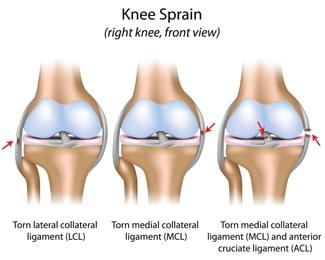for Over 25 Years
Anatomy of A Knee Injury Caused By Trauma
As a personal injury attorney, a knee injury or knee injuries are one of the most common serious afflictions I see stemming from traumatic events such as traffic collisions. In order to understand the complexities that sometimes stem from these injuries, it is important to understand both the structure of the knee and the potential damage it can sustain as a result of trauma.
How Does My Knee Work?
The knees, along with the ankles and feet, are the main weight bearing devices our bodies have to stand, walk, run and move. The knee connects the upper thigh bone (the femur) with the lower shin bones (the tibia and the fibula). The bones are connected by four large ligaments as follows: the Anterior Cruciate Ligament (or ACL) and the Posterior Cruciate Ligament stabilize the femur and tibia and keep them from sliding forward or backward over each other; the Lateral Collateral Ligament attaches the femur to the fibula and the Medial Collateral Ligament attaches the femur to the tibia and both keep the two bones from sliding from side to side. In between the two bones are the Medial and Lateral Meniscus which act as a kind of shock absorber for the joint. This is protected in front by the Patella bone (or knee cap). There are also various Bursae (or fluid-filled sacs that act to lubricate the movement of the joint) and various tendons connecting muscle tissue in and around the knee joint.

What Type of Injuries Can The Knee Sustain Due to Trauma?
There are two main types of derangement that a knee can sustain as a result of a traumatic even such as a car accident, motorcycle collision or slip and fall, namely, fractures of hard bone and tears of soft tissue such as ligaments and thus resulting in a knee injury. Fractures can be to the Patella or to the portions of the Tibia or Fibula that are in and around the knee such as the head of the bone. Tears can include a tearing of the middle portion of any of the various ligaments or a tearing away of the ligaments from the bones. These can include ruptures to the Anterior or Posterior Cruciate Ligaments, the Lateral or Medial Collateral Ligaments and / or the Meniscus and tendon tears. Fractures usually occur from blunt force impact between the bones and some hard object such as an interior portion of a vehicle or the ground or pavement. Tears can also occur from such impact but, are caused from too much tension being placed upon the ligaments in one direction or another.
What Types of Treatment are Available for Traumatic Knee Injury From An Accident?
Some knee injuries can be treated with initial trauma care such as ice and immobilization and will heal with the passage of time. Fractures may require casting or and extended period of keeping the knee fairly immobile and keeping weight off by the use of crutches or other assistive devices. However, many serious knee injuries, especially tears and significant fractures, may require surgical intervention. This can include internal fixation of the bones with hardware if they have been shattered and also repair and / or reattachment of ligaments. Surgery is almost always followed by a period of physical therapy to restore the flexibility and function of the knee.
Why Is It Important to Seek Thorough Medical Examination, Diagnosis and Treatment and Prompt Legal Advice Following A Knee Injury?
We don’t know how much we rely on our knees for mobility until they are impaired. Prompt medical treatment and diagnostic tools such as X-rays and Magnetic Resonance Imaging (MRI) studies are crucial to determine the extent of damage and potential treatments necessary. If the injury was caused by the negligence of another person or entity such as a driver or property owner, it is important to promptly investigate the basis for any claims that could be made. A quality personal injury lawyer can also assist the injured person in seeking quality medical advice (including Orthopedic consultations) and can communicate with these medical professionals to ensure that the claim is not settled unless and until a full and complete determination has been made as to both present problems and future prognosis.
Sources: National Institutes of Health, “Knee Injuries and Disorders” http://www.nlm.nih.gov/medlineplus/kneeinjuriesanddisorders.html












